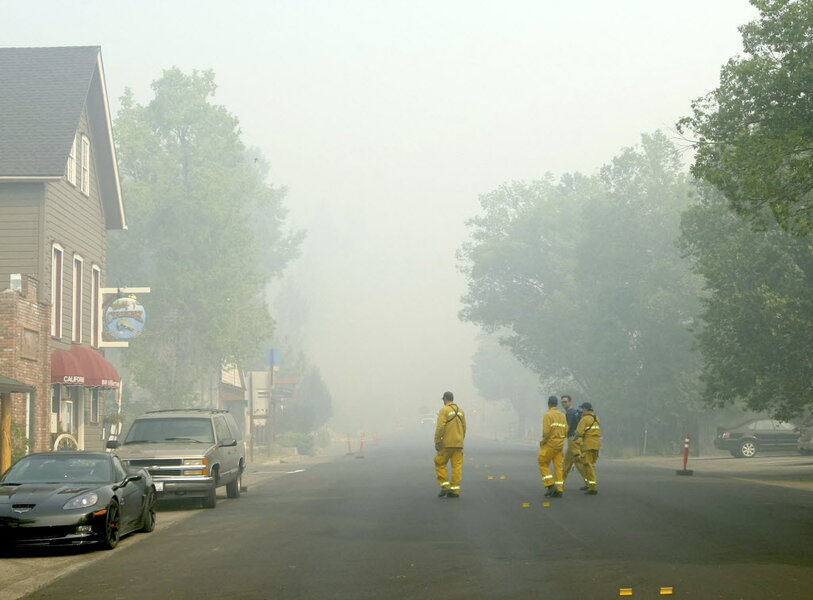West coast wildfires: What's being done to control them
Loading...
Wildfires are sweeping through several dry Western states, including a massive blaze that briefly shut down part of the main interstate between Southern and Northern California. A look at the latest hotspots and what crews are doing to control them:
SOUTHERN CALIFORNIA
About 1,000 people have been evacuated from homes as a 100-acre wildfire burns through brushy canyonlands north of Los Angeles.
Houses and a mobile home park in the Newhall area of Santa Clarita have been emptied. The Los Angeles County Sheriff's Department says about 30 horses also were moved to safer ground.
The fire began shortly after 1 p.m. Wednesday on the shoulder of Interstate 5, briefly closing freeway lanes. Firefighters began to get it surrounded several hours later.
Wind-driven flames were nearing homes, including Dale Lookholder's. He had collected a bag of prescription medications in preparation for evacuating.
"Just my drugs, that's all I care about," Lookholder told KABC-TV. "In the 23 years that we've been here, this is as close as it's gotten. I hope they get a handle on this thing. I just planted flowers."
More than 400 firefighters from agencies around the region are assisting.
Meanwhile, crews relied on retardant-dropping aircraft to battle a huge forest fire that has been burning for a week in an inaccessible area of the San Bernardino Mountains.
The blaze about 90 miles east of Los Angeles was partially contained after burning nearly 30 square miles of old-growth timber. Several hundred people were forced to leave camps and vacation homes.
NORTHERN CALIFORNIA
A wildfire has grown to 26 square miles in hazardous and inaccessible terrain south of Lake Tahoe and is moving closer to structures, officials said.
No buildings have been damaged, but the mountain town of Markleeville remained on standby Wednesday for possible evacuations, according to the Bureau of Land Management. Several campgrounds have been evacuated, and two highways have been closed.
The fire, ignited by lightning Friday, was not at all contained Wednesday.
Air tankers and helicopters helped hundreds of firefighters battle the blaze about 20 miles west of the Nevada border. One firefighter received a heat-related injury Tuesday.
Strong, erratic winds and severe drought conditions have stoked the fire, and smoke can be seen as far away as Carson City, Nevada.
ALASKA
Growing wildfires have led to more evacuations in Alaska's parched interior, with an international mushing champion evacuating his dogs from one of two communities where residents voluntarily fled their homes.
More than 270 fires are burning in Alaska, including one near Eureka that led Yukon Quest International Sled Dog Race champion Brent Sass to evacuate his dogs to Fairbanks, news station KTUU reported.
In Tanana, a tribal nonprofit flew 62 people 130 miles to Fairbanks, focusing on elders, children and people with health conditions. The Tanana Chiefs Conference, a consortium of 42 villages in the interior, also flew six people from the village of Hughes on Tuesday as a precaution in case it gets worse in that village, which is about 10 miles from a fire.
An area just north of Fairbanks also faced an evacuation advisory. Fairbanks, the interior's largest city, also has been smoky because of fires in the region even though it hasn't been directly touched by flames.
There were 40 new fires reported Tuesday, bringing the total of active fires to 278. Altogether, fires have burned nearly 636 square miles.
OREGON
A wildfire scorching a remote part of southwestern Oregon has grown to nearly 8 square miles, but hundreds of firefighters have worked to get it nearly halfway contained.
Incident commander Doug Johnson said fire lines will be tested in the coming days by a heat wave expected to bring triple-digit temperatures to the region.
The lightning-sparked blaze started June 11 and is burning in the Rogue-River Siskiyou National Forest.
WASHINGTON
Cooler temperatures have helped temper the growth of a wildfire burning in Olympic National Park.
The fire was estimated at about 1 1/2 square miles Wednesday. The 950-acre blaze is burning high in the tree tops in a wilderness area about 13 miles north of Quinault. No structures were threatened.
Fire managers say they're monitoring the blaze and fighting it when it's safe.
Park official Todd Rankin says the fire is very unusual for this time of year. It was caused by a lightning strike in late May.







